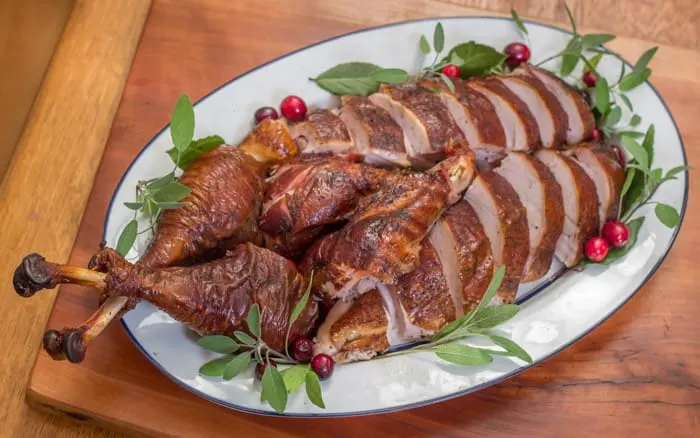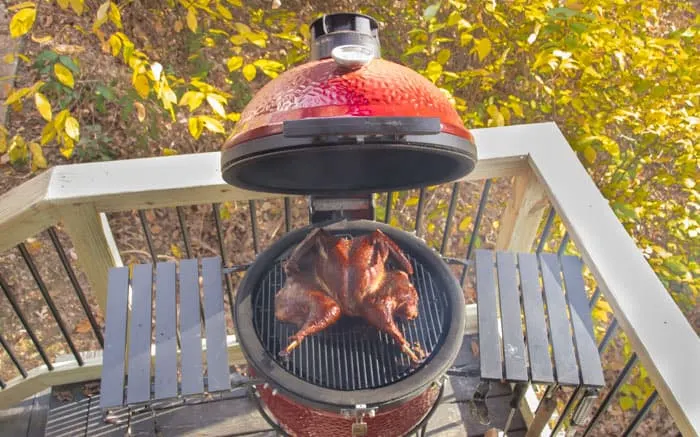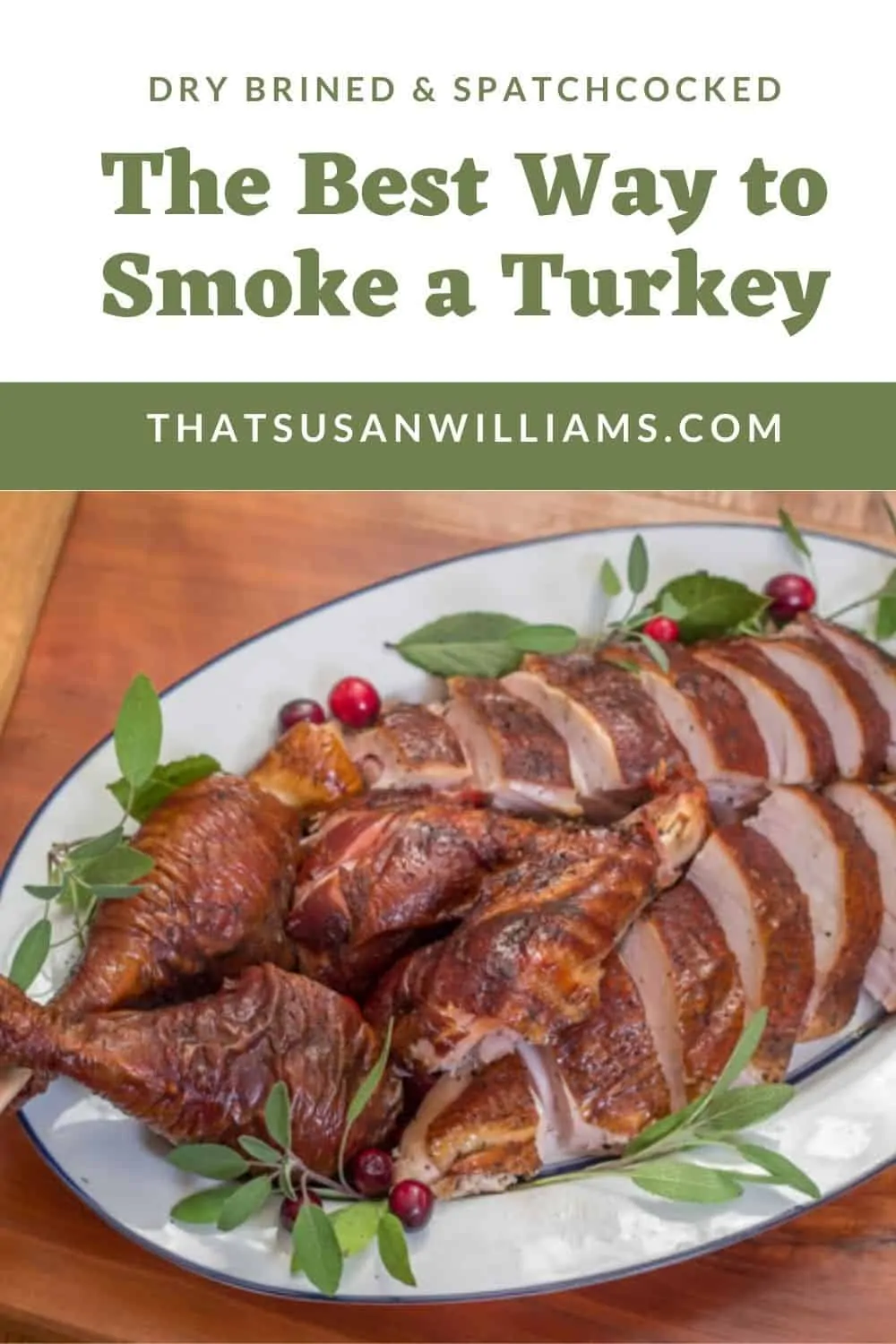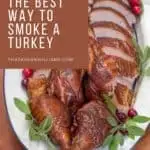This post contains links that, if you click on them and make a purchase, will earn me money. As an Amazon Associate, I earn from qualifying purchases. . Regardless, I only recommend products or services that I believe will be good for my readers. Thanks for helping me continue to produce great content!
Finally, I’ve figured out the best way to smoke a turkey, and I’m going to share all my tips and secrets with you.

I’ve figured out The Best Way to Smoke a Turkey: and here’s a platter full of proof.
It’s taken me a lot of years to be ready to confidently share this smoked turkey post with you. But that’s what the passing of time can do for you, if you’re willing to be taught. And I’m always willing to be taught, when it comes to learning how to prepare more delicious food. Anything that makes my family and friends time around the table more delicious, and more pleasant, is what I’m all about.
How Many Ways Can You Make a Turkey?
Just like Thomas Edison finding a lot of ways NOT to make a light bulb, I’ve found a lot of ways that are….pretty OK…when it comes to making a turkey. But none of them were the best. Each had drawbacks.
- I’ve roasted.
- I’ve brined and roasted.
- I’ve grilled.
- I’ve brined and grilled.
- I’ve smoked.
- I’ve spatchcocked.
And now, I can say with some gratitude, that the combination of spatchcocking, dry brining, and smoking is THE WINNER AND CHAMPION!!!
What is Spatchcocking, and Why Do It?
Spatchcocking (which is sometimes called butterflying) a turkey means to remove the backbone of the bird. We use the sharpest, strongest scissors in the house for that. Some of you may have poultry shears, and if you do, this is the opportune moment to pull those out. Some people use a knife to remove the backbone. You do whatever works best for you, given the tools at your disposal.
I freeze the back bone in a ziplock bag, along with the turkey innards (minus the liver) to make turkey stock, and I’ll be using that turkey stock in various dishes, like my stuffing, and my gravy. The liver has a livery flavor that I don’t like so much in my stock, but it’s a perfect treat for Gus, my German Shepherd.
Once the back bone is removed, flip that bird (heh heh) so that it is breast up, and pretend like you’re a chiropractor (since you’re pretending, you’re going to need to pretend that this breastbone you’re about to bear down on is a back bone), and give that bird the best/worst chiropractic adjustment of its former life. You’ll hear a satisfying/horrifying pop/crunch sound, which is exactly what you want to hear. You’re trying to flatten this turkey out like it’s a toad on the road, following a close encounter with a truck. (The Aussies call this “toading”. No kidding!)
“But WHY???”, I hear your anguished cry. Well, dear, it’s because turkeys are notorious for their dried out breast meat, which happens because the thigh takes the longest to get done, because it’s all squished up there next to the breast, and cooks last. Meanwhile, the breast is getting dry. By spatchcocking your bird, you’re overcoming an anatomical issue.
Thanks to your spine-ectomy and chiropractic adjustment, all parts of your bird are going to cook more evenly, since they’re all exposed to the heat evenly. See what I mean?

Into the smoke goes your perfectly seasoned, perfectly…splayed….toaded…spatchcocked beauty.
Why Dry Brine?
For years I made a brine out of water, salt, honey, garlic, thyme, and juniper, and soaked my turkey in it overnight. And it was good. The turkey was certainly juicier than a plain old roasted turkey. So…why change?
Salting meat does a better job than brining of causing those muscle cells to absorb the salt, and with dry brining, you have the advantage of being able to dry age the meat. This is the same principle I discussed with you in my post on How to Get that Expensive Steak House Taste at a Fraction of the Price. Dry-aging meat allows the meat to tenderize, while the flavor intensifies, due to a very slow evaporation of fluid.
So, to sum up, dry brining means you apply the spice rub, and then allow the bird to sit uncovered in your fridge for 4 days. This causes the meat to both tenderize, and become more intense in flavor. At the end of those 4 days, take the bird out of the fridge, allow it to sit on the counter for about an hour to come closer to room temp, and then, you’re ready to smoke that birdie!
Why Smoke A Turkey, Rather Than Grill A Turkey?
I hesitate to say this, but if you’ve ever had a smoked turkey, there would be no need to ask this question. It adds so. much. FLAVOR!
Grilled is good. Smoked is better!
And, because you’ve spatchcocked your turkey, your meat is going to be OUTSTANDINGLY juicy, because you didn’t cook it too long and dry out the breast. No need to inject it or plump it up with fluid. A properly cooked turkey will be juicy.

Time to exit the smoking section, little birdie.
No Basting Required
The beauty of this recipe is that truly: no basting is required. If you can hold your smoker/grill at the proper temperature of 275º, your bird will cook all on its own, without your help. Low maintenance! How lovely.

Please, pin this on Pinterest.
And now, here’s the recipe for
The Best Way to Smoke a Turkey: Spatchcocked, Dry-Brined, and Smoked
The Best Way to Smoke a Turkey

The Best Way to Smoke a Turkey: all the tips you need (including how to spatchcock, and dry-brine) to produce the most amazing turkey you'll ever make.
Ingredients
- 3 1/2 tablespoons kosher salt
- 1 1/2 teaspoons rubbed sage
- 1 1/2 teaspoons dried thyme
- 1 1/4 teaspoons whole black peppercorns
- 1/2 teaspoon whole allspice berries
- 1 10 lb. whole turkey, neck and giblets removed and reserved for Giblet Stock
Instructions
- For the Spice Rub: Four days before you’re planning on serving the turkey, place the salt, sage, thyme, black peppercorns, and allspice into a spice grinder or VitaMix Blender and pulse until the peppercorns and allspice are coarsely ground, 5 to 6 pulses. Set aside.
- To Spatchcock the Turkey: Remove the backbone using either poultry shears or an electric knife. Put the backbone in a Ziplock bag and freeze with the neck bone and the organs, to be used in making turkey stock. Flip the turkey over, and press down on breastbone until you hear a satisfying/horrifying crunch, and the bird has flattened slightly. Spread turkey appendages until turkey appears positively wanton, completely promiscuous…or relaxed.
- Apply spice rub to both sides of turkey, all over and around, including places where the sun has never formerly shone.
- Place the turkey on a half sheet pan, breast side up with legs running alongside the long edge of the pan. Store, uncovered, in the refrigerator for 4 days.
- After 4 days, remove the turkey from the refrigerator, and leave at room temperature for 1 hour.
- Smoke the turkey at a nice steady 275º.
- Smoke for approximately 2-3 hours, until the turkey thigh and breast reach a temperature of 160º-165º. Poultry needs to reach 165º to be safe to eat, but your turkey’s temperature will continue to rise for a bit after you take it off the grill. Our turkey weighed 10 lbs, and took about 2 1/2 hours to cook, although your experience will depend upon how steady you were able to maintain the cooking temperature.
- Let bird rest for an hour. Keep all dogs and other forms of scavengers away. (While it rests is the time to make the gravy, and warm the stuffing and the rolls.)
- Carve, and enjoy.
Recommended Products
As an Amazon Associate and member of other affiliate programs, I earn from qualifying purchases.
Nutrition Information:
Yield:
10Serving Size:
1Amount Per Serving: Calories: 891Total Fat: 35gSaturated Fat: 10gTrans Fat: 0gUnsaturated Fat: 22gCholesterol: 545mgSodium: 2734mgCarbohydrates: 3gFiber: 1gSugar: 1gProtein: 133g







